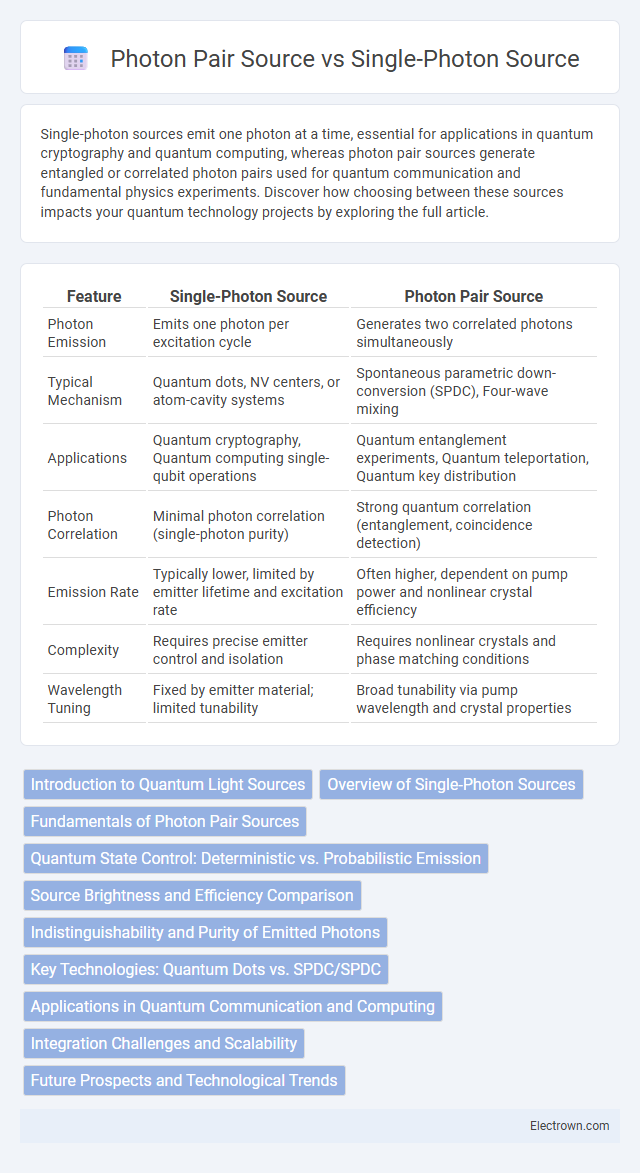Single-photon sources emit one photon at a time, essential for applications in quantum cryptography and quantum computing, whereas photon pair sources generate entangled or correlated photon pairs used for quantum communication and fundamental physics experiments. Discover how choosing between these sources impacts your quantum technology projects by exploring the full article.
Table of Comparison
| Feature | Single-Photon Source | Photon Pair Source |
|---|---|---|
| Photon Emission | Emits one photon per excitation cycle | Generates two correlated photons simultaneously |
| Typical Mechanism | Quantum dots, NV centers, or atom-cavity systems | Spontaneous parametric down-conversion (SPDC), Four-wave mixing |
| Applications | Quantum cryptography, Quantum computing single-qubit operations | Quantum entanglement experiments, Quantum teleportation, Quantum key distribution |
| Photon Correlation | Minimal photon correlation (single-photon purity) | Strong quantum correlation (entanglement, coincidence detection) |
| Emission Rate | Typically lower, limited by emitter lifetime and excitation rate | Often higher, dependent on pump power and nonlinear crystal efficiency |
| Complexity | Requires precise emitter control and isolation | Requires nonlinear crystals and phase matching conditions |
| Wavelength Tuning | Fixed by emitter material; limited tunability | Broad tunability via pump wavelength and crystal properties |
Introduction to Quantum Light Sources
Quantum light sources generate individual or correlated photons critical for quantum communication and computing. Single-photon sources emit one photon at a time, essential for secure quantum key distribution and quantum cryptography. Photon pair sources create entangled or correlated photon pairs through processes like spontaneous parametric down-conversion, enabling quantum entanglement and advanced quantum networks.
Overview of Single-Photon Sources
Single-photon sources emit individual photons on demand, essential for quantum communication, quantum computing, and secure cryptographic protocols. These sources differ from photon pair sources, which generate entangled photon pairs through processes like spontaneous parametric down-conversion, enabling quantum entanglement experiments but not always guaranteeing single-photon emission per event. Your choice of source depends on application requirements, with single-photon sources offering higher precision and control for tasks requiring strict photon number regulation.
Fundamentals of Photon Pair Sources
Photon pair sources generate two entangled photons simultaneously through nonlinear optical processes such as spontaneous parametric down-conversion or four-wave mixing, enabling quantum communication and computing applications. These sources produce correlated photon pairs with properties like time, polarization, or frequency entanglement, which are crucial for protocols relying on quantum entanglement. Your choice between single-photon and photon pair sources depends on the requirement for entanglement and the complexity of the quantum system you intend to implement.
Quantum State Control: Deterministic vs. Probabilistic Emission
Single-photon sources offer deterministic emission by generating one photon on demand, enabling precise quantum state control essential for scalable quantum computing and secure communication. In contrast, photon pair sources rely on probabilistic emission through spontaneous parametric down-conversion or four-wave mixing, producing correlated photon pairs with inherent randomness that limits deterministic quantum state preparation. The deterministic nature of single-photon sources ensures higher fidelity and reduced multi-photon contamination compared to the probabilistic behavior of photon pair sources.
Source Brightness and Efficiency Comparison
Single-photon sources typically exhibit lower brightness compared to photon pair sources due to the challenge of generating one photon at a time with high fidelity. Photon pair sources, such as spontaneous parametric down-conversion (SPDC) or four-wave mixing (FWM), enable higher brightness because they produce correlated photon pairs more efficiently, often measured as coincidence rates. Your choice depends on efficiency needs; photon pair sources offer higher brightness but require additional filtering or heralding to isolate single photons, impacting overall system efficiency.
Indistinguishability and Purity of Emitted Photons
Single-photon sources typically exhibit higher indistinguishability due to the emission of independent photons with controlled quantum states, enhancing their suitability for quantum information processing. Photon pair sources, such as spontaneous parametric down-conversion, often generate entangled photons with correlations that can reduce single-photon purity because of multi-photon emission probabilities. The purity of emitted photons from single-photon sources generally surpasses that of photon pair sources, which is critical for applications requiring high-fidelity quantum interference.
Key Technologies: Quantum Dots vs. SPDC/SPDC
Quantum dots provide a deterministic single-photon source with high purity and indistinguishability, essential for scalable quantum computing and secure quantum communication. In contrast, spontaneous parametric down-conversion (SPDC) generates photon pairs probabilistically, often requiring heralding to identify the presence of single photons, which impacts overall efficiency. Your choice between quantum dots and SPDC depends on the application's demand for photon generation rate, quality, and integration with quantum networks.
Applications in Quantum Communication and Computing
Single-photon sources enable secure quantum key distribution by providing true single photons essential for protocols like BB84, ensuring high-fidelity quantum communication. Photon pair sources, often based on spontaneous parametric down-conversion, generate entangled photon pairs crucial for quantum teleportation and entanglement-based quantum computing algorithms. The choice between single-photon and photon pair sources directly impacts the scalability and security of quantum networks and computation architectures.
Integration Challenges and Scalability
Single-photon sources often face integration challenges due to their need for precise control over emission properties and coupling efficiency with on-chip photonic circuits. Photon pair sources, such as those based on spontaneous parametric down-conversion, provide greater scalability but require complex filtering and multiplexing to isolate single photons from multi-pair emissions. Your choice depends on balancing the trade-offs between integration complexity and the scalability demands of quantum photonic applications.
Future Prospects and Technological Trends
Single-photon sources and photon pair sources play pivotal roles in advancing quantum communication and computing technologies, with single-photon sources offering improved security in quantum key distribution while photon pair sources enable entanglement-based protocols crucial for quantum networks. Emerging trends focus on integrating these sources with scalable photonic circuits and enhancing their brightness, purity, and indistinguishability to meet the demands of large-scale quantum systems. Your choice between these technologies will shape the potential for secure quantum information processing and the development of next-generation quantum devices.
single-photon source vs photon pair source Infographic

 electrown.com
electrown.com